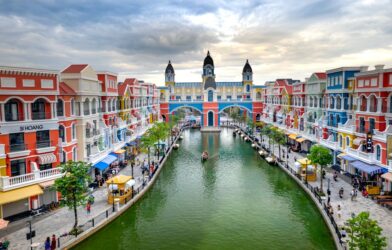Europe is a continent rich in history, art, and diverse cultures, making it a treasure trove of cultural attractions. From ancient ruins to world-class museums, Europe offers an array of experiences that reflect its vibrant heritage. Whether you’re an art lover, a history enthusiast, or simply seeking to immerse yourself in new cultures, here are some of the top cultural attractions to explore across Europe.
The Louvre Museum, Paris, France
The Louvre Museum is one of the largest and most famous art museums in the world, renowned for its vast collection of art and artifacts. Housed in a former royal palace, the Louvre boasts masterpieces such as the Mona Lisa, the Venus de Milo, and countless other works spanning thousands of years and various civilizations. Visitors can easily spend days exploring its extensive galleries, which include everything from ancient Egyptian relics to Renaissance paintings. The museum’s architecture, including the iconic glass pyramid entrance designed by I.M. Pei, adds to its allure, making the Louvre a must-visit cultural landmark in Paris.
The Colosseum, Rome, Italy
The Colosseum is an iconic symbol of ancient Rome and a testament to the engineering prowess of the Roman Empire. This colossal amphitheater, completed in AD 80, once hosted gladiatorial contests, public spectacles, and other events that drew crowds of thousands. Visitors can explore the ruins, learning about the history and significance of this remarkable structure through informative exhibits and guided tours. Standing in the Colosseum, one can almost hear the echoes of the past, envisioning the grandeur of the games that once captivated audiences. A visit to the Colosseum is essential for anyone wishing to understand the rich history of Rome.
The British Museum, London, England
The British Museum is one of the world’s premier museums, housing a vast collection of art and antiquities from diverse cultures spanning over two million years. Notable artifacts include the Rosetta Stone, the Elgin Marbles, and an extensive collection of Egyptian mummies. The museum’s galleries offer an in-depth look at human history, showcasing objects that tell the stories of different civilizations. Admission to the British Museum is free, allowing visitors to explore its treasures without financial barriers. With its comprehensive exhibits and rich history, the British Museum is a cultural landmark that attracts millions of visitors each year.
The Acropolis, Athens, Greece
The Acropolis of Athens is an ancient citadel that stands as a symbol of classical civilization. Dominated by the Parthenon, a temple dedicated to the goddess Athena, the Acropolis offers breathtaking views of the city below and is a UNESCO World Heritage Site. Visitors can explore the ruins, including the Erechtheion and the Temple of Athena Nike, while learning about the significance of these structures in ancient Greek culture. The Acropolis Museum, located nearby, houses artifacts and sculptures from the site, providing further context to this iconic landmark. A visit to the Acropolis allows travelers to connect with the foundations of democracy, philosophy, and art.
The Palace of Versailles, France
The Palace of Versailles is a stunning example of opulent architecture and gardens, reflecting the grandeur of the French monarchy. Located just outside of Paris, this former royal residence was the home of Louis XIV and is known for its lavish rooms, including the Hall of Mirrors and the King’s Apartments. Visitors can wander through the meticulously manicured gardens, which feature fountains, sculptures, and picturesque pathways. The palace is also home to a variety of art collections and exhibitions that explore the history of France. A visit to Versailles provides insight into the excesses of royal life and the cultural significance of this remarkable site.
The Vatican Museums and St. Peter’s Basilica, Vatican City
The Vatican Museums are a must-see for anyone interested in art and history. Home to an extensive collection of art amassed by the Catholic Church over centuries, the museums showcase works by renowned artists such as Michelangelo, Raphael, and Caravaggio. The highlight of the visit is the Sistine Chapel, famous for Michelangelo’s breathtaking ceiling frescoes. Adjacent to the museums, St. Peter’s Basilica is one of the largest and most impressive churches in the world, featuring stunning architecture and art, including Michelangelo’s Pietà. Together, the Vatican Museums and St. Peter’s Basilica represent the pinnacle of Renaissance art and religious significance, attracting millions of visitors each year.
The Rijksmuseum, Amsterdam, Netherlands
The Rijksmuseum is the national museum of the Netherlands, celebrated for its collection of Dutch Golden Age paintings. Home to masterpieces by artists like Rembrandt, Vermeer, and Hals, the museum offers an unparalleled look at Dutch art and history. The museum’s stunning architecture, with its neo-Gothic façade and beautiful gardens, enhances the visitor experience. In addition to its art collections, the Rijksmuseum also hosts exhibitions that explore various aspects of Dutch culture and history, making it a cultural hub in Amsterdam. A visit to the Rijksmuseum provides a deeper understanding of the Netherlands’ artistic legacy and its impact on European culture.
The Anne Frank House, Amsterdam, Netherlands
The Anne Frank House is a poignant cultural attraction that honors the memory of Anne Frank, a Jewish girl who went into hiding during World War II. The museum is located in the actual building where Anne and her family hid from the Nazis for over two years. Visitors can tour the hidden annex, learning about Anne’s life and the impact of the Holocaust through her poignant writings and personal artifacts. The museum serves as a powerful reminder of the importance of tolerance, human rights, and the need to confront prejudice. A visit to the Anne Frank House offers a deeply moving experience that encourages reflection and understanding.
The Prado Museum, Madrid, Spain
The Prado Museum is Spain’s premier art museum, housing one of the finest collections of European art in the world. With works by masters such as Velázquez, Goya, and El Greco, the museum offers a comprehensive overview of Spanish art history. Visitors can explore the extensive galleries, which feature paintings, sculptures, and decorative arts from the 12th to the early 20th century. The museum also hosts temporary exhibitions that showcase works from other cultures and time periods, providing a broader context for understanding art. A visit to the Prado Museum is essential for anyone wishing to appreciate the depth and richness of Spanish artistic heritage.
The Sagrada Familia, Barcelona, Spain
The Sagrada Familia is an architectural masterpiece designed by the renowned architect Antoni Gaudí. This basilica, still under construction after more than a century, is a UNESCO World Heritage Site and one of Barcelona’s most famous landmarks. Its intricate facades and towering spires are a testament to Gaudí’s visionary design, blending Gothic and Art Nouveau styles. Visitors can explore the interior, where the play of light through stained glass creates a breathtaking atmosphere. The Sagrada Familia is not only a symbol of Barcelona but also a representation of Gaudí’s dedication to his craft and his belief in the connection between nature and architecture. A visit to this iconic site is an unforgettable experience.
Europe is home to countless cultural attractions that offer insights into the continent’s rich history and artistic legacy. Each destination provides a unique opportunity to explore the influences that have shaped European culture over the centuries. From world-renowned museums to ancient ruins, these cultural landmarks invite visitors to engage with the stories and traditions that define the diverse nations of Europe. Whether you are wandering through the halls of the Louvre, marveling at the grandeur of the Colosseum, or reflecting on the legacy of Anne Frank, each experience is a journey into the heart of European culture.








Comments are closed